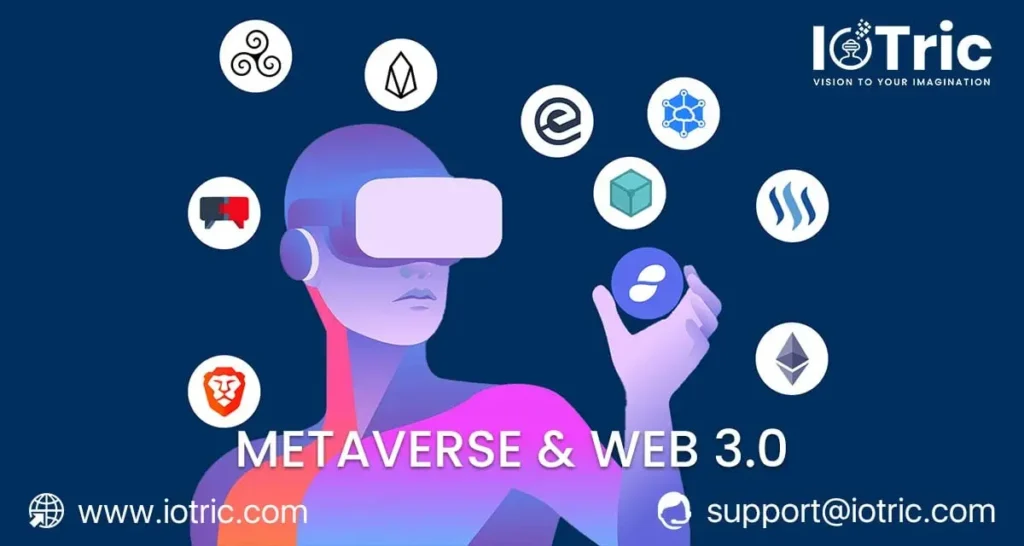AR/VRBlockchain Technology
Metaverse and Web 3.0

Let’s see what actually Metaverse and Web 3.0 is all about.
Introduction
Metaverse is a universe of social media, augmented reality, virtual reality, online gaming, and cryptocurrencies that allow the users to interact, and build social connections virtually. Metaverse came in the era of the recent Internet evolution known as Web 3.0. Instead of engaging with conventional digital content, the metaverse users will be able to immerse themselves in hybrid (physical + digital) worlds. In other words, metaverse is a shared environment accessed by people via the internet where AR and VR are specifically combined to create a sense of ‘virtual presence’. Moreover, it is a set of virtual spaces where users can create and explore with each other who aren’t in the same physical space. Meanwhile, the growing metaverse can create more multidimensional online spaces.

Compositions of Metaverse
Metaverse is not a specific technology but interaction between the technologies. The technologies included in Metaverse are:
Virtual Reality
Virtual Reality owns prominent features of synthetic views in which users with VR headsets need to pay full attention to the virtual environments, separate from physical worlds. While in metaverse, the users will create contents in the digital twins. Commercially, Virtual environments in Metaverse allows user to create digital contents such as VR painting that they can monetize later using NFT.
Augmented Reality
Augmented Reality delivers alternate experiences to users in their physical surroundings with computer-generated virtual contents. It creates an enhanced real world by making the use of digital visual elements delivered via technology. Users with AR in the physical world simultaneously communicate with virtual counterparts in the metaverse. AR will allow the users to see the actual environment through screens of their phones or tablets by using smart glasses, and make virtual changes on the screen.
Mixed Reality
Mixed reality is a blend of digital and physical worlds and unlock natural and intuitive 3D interactions between human and environment. It allows a person to wear an MR headset to experience real world objects, and trigger virtual world reactions.
Difference between Metaverse and Web 3.0
- Metaverse is a computer domain to ensure interaction with 3D objects through VR glasses. Web 3.0 represents management of digital assets and online identities. The users may produce and monetize their content using Web 3.0.
- Metaverse features enable the whole ecosystem with connection, interface, experiences, decentralization, and supporting technology. Whereas, Web 3.0 focuses only on decentralized web using blockchain and cryptocurrency.
- Metaverse combines entertainment, education, gaming, movies, social networks, and simulated networks. On the other hand, web 3.0 is a new version of the internet and applicable to the whole web rather than specialized applications.
Similarities between Metaverse and Web 3.0
Along with differences, there are some similarities between Metaverse and Web 3.0
- Metaverse and Web 3.0 are both are being refer as ‘Decentralized ‘for most of the applications.
- Both are utilizing Artificial Intelligence to create an advanced interface.
- Both are ready to assist users throughout IoT based digitization and next generation technologies.
Future scope
The giant companies such as Apple, Google, and Facebook are stepping towards Metaverse with ambitious plans to materialize the immersive technologies. In the upcoming years, our virtual world will look radically different with progressive development, and engagement of emerging technologies. Along with this, our digitized future will be more interactive, alive, and multiple using powerful immersive technologies.
Future challenges
Besides remarkable benefits of Metaverse technologies, the businesses may also face certain challenges. Synchronization and management of dynamic states at a scale will be a huge challenge. Specially, while considering unlimited concurrent users to collectively act on virtual objects, and interact with others without sensible latency. Latency is the factor that may negatively impact the user experiences in Metaverse. Along with this, the creation and management of virtual assets such as digital twins and avatars will also have great challenges while protecting users against digital copies. Such copies can modify users’ behavior and they can influence to expose more personal information to avatars. Moreover, Metaverse expands the definition of ‘personal data’ for which basic privacy regulations will not be significant. Future security of metaverse, will need to consider the rights of minorities and vulnerable communities. Otherwise, unlike in traditional socio-technical systems, potential mistreatment would have more disastrous consequences.
Conclusion
Web 3.0 is the next generation of the internet that is evolving the methods of user control on their digital creations, assets, identities, and content. Whereas, metaverse is the part of Web 3.0 that promises to deliver immersive experiences and environments for the users. It has potential to attract more buyers for the businesses in an interactive manner and help them to gain higher profit margins. However, its full-fledged adoption is prone to certain challenges such as latency, legacy security mechanism, and synchronization related issues.